Kevin McCarthy Celebrates 40 Year Anniversary with Dover Motion
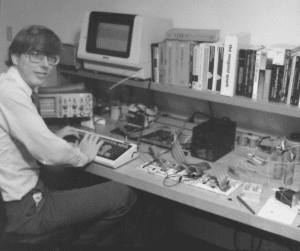 April marked a very special milestone for Dover Motion. Kevin McCarthy, Chief Technology Officer, celebrated his 40-year anniversary with us. With forty years of experience on thousands of positioning systems, Kevin possesses an unparalleled knowledge of all aspects of precision motion. With his physics and optics background, and years of experience designing custom solutions in cutting edge fields, Kevin brings exceptional context sensitivity to understanding his customer’s underlying needs.
April marked a very special milestone for Dover Motion. Kevin McCarthy, Chief Technology Officer, celebrated his 40-year anniversary with us. With forty years of experience on thousands of positioning systems, Kevin possesses an unparalleled knowledge of all aspects of precision motion. With his physics and optics background, and years of experience designing custom solutions in cutting edge fields, Kevin brings exceptional context sensitivity to understanding his customer’s underlying needs.
Kevin’s expertise goes far beyond his precision motion core. Kevin is as comfortable discussing the latest developments in camera and optics technologies, DNA sequencing, and fluorescence microscopy as he is discussing astronomy, AFMs, semiconduction inspection, fiber optic positioning, satellites, or any number of additional precision motion use cases.
I had the pleasure to interview Kevin McCarthy, a natural born storyteller. In this article, we’ll take a look at Kevin’s very interesting path to CTO at Dover Motion, as well as celebrate his amazing accomplishments along the way. I just hope that I can do his stories justice.
Kevin McCarthy has always been a builder, creator, and a maker by design with an unparalleled passion for science which drove many milestones throughout his career. At a very early age, Kevin’s interest in physics, optics, astronomy, microscopy, and fluorescence paved the way for what would end up being 40 years of progress in precision positioning.
Kevin grew up in Atlantic City, NJ and in the 4th grade he discovered a local tourist shop on the boardwalk which sold rocks, minerals, and crystals. Kevin was in awe of this place. At one point, the couple that owned the shop noticed that Kevin was spending a lot of time there, and asked him if he wanted a job. Imagine Kevin’s parents’ reaction when he went home that day and explained to them that he had a job. A 4th grader with a job! His “salary” was a small credit to be used in the store which was, in part, how he started his mineral collection, another story altogether.
At the back of the shop, there was a dark, enclosed mineral exhibit with two eye holes to allow customers to look inside, with a button they could press to turn on short and longwave ultraviolet lights. These illuminated a spectacular collection of fluorescent minerals, which blew Kevin’s mind. And so began Kevin’s fascination with fluorescence, which continues to this day.
Atlantic City was a convention city with a huge tradeshow hall and lots of different types of shows. When he wasn’t in school, or working at the mineral shop, Kevin could be found sneaking into the educational conventions to look at the microscopes and telescopes on display for the science teachers who were looking for new science programs and gear for their classrooms. For one of the demonstrations, the exhibitor would put paramecium, a single celled organism with little flagella, in water on a microscope slide. Kevin would look in the microscope and see these moving organisms. Kevin thought this was just amazing, and so, he added a microscope to his Christmas list. Later he added a telescope and an ultraviolet lamp for fluorescent minerals. When relatives would come over for holidays, Kevin would insist on puncturing their skin with a needle. He would squeeze out some blood so that he could excitedly show them their red and white blood cells under his microscope. Except they weren’t really the biggest fans of this particular experiment.
When Kevin was a sophomore in high school, he ran for the elected office of President of the Science Club, which he won. Kevin’s sole executive action was to establish the first ever cash prize for the science fair, which he proceeded to win first prize for the next few years. Ethical clarification: the impartial judges were science teachers! One of his projects that won was an 8-inch diameter telescope that he ground, polished, and silvered from scratch. And the next year, his senior year, Kevin created a CO2 laser from chemistry condensers that was 2 meters long, which also won first prize.
After Kevin graduated from MIT with a BS degree in Physics, he went to live on a 70-acre farm in southern New Hampshire with a few of his MIT friends and their significant others. One of the ways they supported themselves was producing apple cider. They built a cider press and grew it to a 70,000 gallon a year business. At first, the cider press was a completely manual and time-consuming process. As they were scaling the business, they struggled to keep up with production. Kevin was determined to automate the process. He developed an automated cider bottling system that was effortless to operate, and allowed for vastly increased production of cider. And then, Kevin sold those machines to orchards throughout New England, and an orchard equipment supply company then bought the business outright.
While living on the farm, Kevin would frequent a machine shop in Boston and for a few dollars an hour, would rent time on the machines. It was here that Kevin was introduced to the owner of a company called Slide Center, who produced advertising graphics by transilluminating a slide and imaging it with a camera in multiple iterations. The company owner was looking to be able to have an XY Theta table with a joystick and be able to cruise around on top of the light table and move the slide anywhere to take the needed photos. So it was there that Kevin was commissioned to design his first XY stage, and in 10 weeks he delivered the XY Theta open frame (because the light has to go through the XY Theta stage).
About a year later, the owner of the Slide Center was very pleased with the motorized XY stage, but asked if Kevin could program the stage so it would automatically perform move sequences and turn on the camera. This was no problem for Kevin. He was going to write the code himself, when he came across a local company called Instrument Industries, which is now part of Dover Motion, that had recently enlisted a consultant to develop this technology. Kevin met with Roger Roach, and ended up purchasing their control and integrating it with his X-Y-Theta stage at the Slide Center.
It was at the farm that Kevin met and married his wife Danielle, a talented artist. They would go on to raise two wonderful daughters, of which they are very proud, and a few years ago celebrated their 40th wedding anniversary together.
After 7 years living on the farm, Kevin knew it was time to get a “real job”. He initially viewed this as having to get a job in “industry”, which sounded very boring and not at all appealing. Kevin serendipitously stumbled across a Help Wanted ad in the Boston Globe looking for a stepping motor product engineer for New England Affiliated Technology (NEAT). The newspaper happened to be several weeks old, but given his experience with stepper motors, he decided to give it a shot anyway. The company happened to be the same company as Instrument Industries, where Kevin had purchased a controller a year prior to re-sell to Slide Center. When Roger realized it was Kevin calling about the position, he agreed to meet with him right away. Kevin would go on to become Vice-President and then President of NEAT, sharing ownership of the company with Roger. And that was the start of Kevin’s 40-year career with NEAT, which is now Dover Motion. In 1999, Kevin and Roger sold NEAT to public Kollmorgen, which was subsequently acquired by Danaher, and eventually split out as a part of Fortive.
Kevin was very busy in the first few years designing stages and additional motion control products, including the NEAT 200 and 301 series. That latter product was based on a third party motion control board, but its ease of use was pretty terrible, and its weaknesses and deficiencies were abundantly clear. Kevin used his experience from using and selling the NEAT-301 to design the NEAT 310M, a programmable microstepping drive and control, which had a 25 year run with thousands of units sold, with ‘ease of use’ being its central feature. Kevin was constantly thinking about how to improve products and to push the envelope with what technology could achieve.

At work circa 1986 developing the “DPS-2000”
The single axis products led Kevin to develop a multi axis product, which was the DPS 2000. This was a four axis motion controller, again all stepper, which was way ahead of its time. It had a 3 1/2 inch floppy disk drive in its front panel, which Steve Jobs had just introduced on the Mac. The 3 ½ floppy, a simple menu based keypad, and assembly code combined to enable automated motion to happen, which was very cool. But in those days, the resolutions were utterly different than they are today.
In those early years, the typical stage resolution was 0.001”, about 25 microns. That began an arms race in which customer requirements were always a little more precise than what we could do at the time, which drove technological innovation in position resolution. During the last 40 years of progress in position resolution, Kevin has always ensured that we stayed ahead of the pack.
Dover Motion’s latest in house designed linear encoder, the Dover Ultra, has a resolution that can be set as low as 305 picometers. That’s basically a little less than 1/3 of a nanometer, which is pretty much identical to the Van der Waals diameter of a single aluminum atom. That’s literally Atomic Level Positioning! Kevin never would have dreamt that we would have gotten here 40 years ago. From 25,000 nanometers down to 1/3 of a nanometer, a factor of almost 100,000 (or “five logs”, as Kevin would say).
Back in the day, motion controllers were fairly large. Around the turn of the Millennium, Kevin had a vision that it should be possible to put a high performance servo drive and control inside a compact stage. At the time he dubbed the concept IntelliStage. However, the technology to achieve this wasn’t available yet, but it remained a goal for Kevin, and he never took his eyes off the prize. Every year that went by, Kevin was both surprised and delighted that none of our competitors had beaten him to the punch. More on this later.
In the digital pathology space, one application that Kevin is very proud of has saved countless women’s lives across the planet. When introduced to the startup company back in 2003, they had already purchased 20 XYZ stages from a competitor, and that competitor made the singular mistake of choosing resonant piezo actuators for all three axes. Kevin describes resonant piezo motion as interesting but pretty terrible technology for precision positioning. Most OEM’s who try to use it encounter problems, which this company inevitably did. To quote Kevin, “my simple question to them was: “How much pain are you experiencing?” They seemed enormously relieved to hear that someone recognized that they had a problem, and they proceeded to tell him how bad it was. “It gets stuck and starts buzzing, which is a function of how long it’s been running, where it is along travel, how many hours it had been operating, and the preload, not to mention the fact that it is generating particulates”.
Kevin suggested they use Dover Motion’s noncontact, direct drive, linear motor technology for XY slide positioning, and also for Z objective focusing, using a novel flexure-based direct-drive stage in place of the piezo actuators. The company ended up retiring the 20 units that they had purchased from a competitor, and bought their first batch of Dover Motion systems.
The company achieved FDA approval in 2005, and the product has been an enormous hit. It dominates cervical carcinoma screening across the planet, and has for over fifteen years. Dover Motion has supplied thousands of these systems, which consist of a 3 axis motion system mounted to a lightweight casting. The system is essentially a high-speed automated microscope, taking digital images of cervical carcinoma samples at over twenty fields of view per second. Unlike traditional human cytology, where an operator might need to view a thousand or more slides a day, maybe towards the end of the day they’re looking to join their mates at the pub and aren’t paying quite so close attention, and something deadly could slip by. In this case, the automated system images the entire slide, and chooses the 22 most malformed nuclei to present to a pathologist. This system has proven to be a very effective tool for reducing cervical carcinoma.
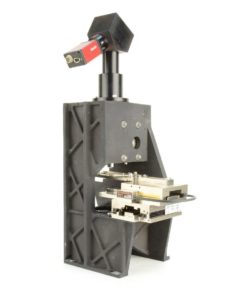
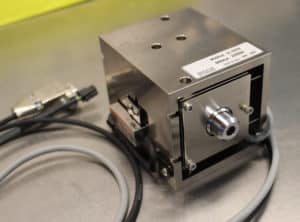
Three axis cervical carcinoma screening microscope and focus axis
Another positioning system that Kevin is proud of began operation at the end of 1995, and is still going strong today. As the most expensive pair of short-travel (160mm) stages that NEAT ever produced, what is truly unique lies in where they are installed. That would be on the SOHO (Solar and Heliospheric Observatory) satellite, a joint NASA-ESA mission that is located at L1, a whopping 1.5 million kilometers sunward from Earth. That is nearly four times as far as the Moon, and over 5,000 times the typical altitude of low earth orbiting satellites. Despite having been originally planned as a two year mission, SOHO is still going strong a remarkable twenty-seven years later, and is funded through at least 2025. Both his stages and the entire SOHO satellite encountered some alarming twists and turns over the years; too long a story for this bio, but do ask Kevin to recount the story sometime, perhaps with a libation in hand.
Never having forgotten his formative years spent at the rock shop on the boardwalk looking at bright minerals fluorescing under UV light, Kevin was able to wed his interest in fluorescence with his passion for solving unique motion challenges. This conjunction reached its apotheosis in 2007, when Kevin was solicited by world-renowned Harvard geneticist, George Church and his colleague Rich Terry, to address the motion requirements for a Gen 2 DNA sequencer that they were interested in developing. The leading detection technique for gene sequencing was – and remains today – fluorescence microscopy, and together George, Kevin, and Rich discussed how to architect a second generation DNA sequencer based on this technique.
After some initial meetings, it became clear to Kevin that he and his colleagues had all the requisite skills to offer not just the compelling motion sub-assembly needed for the project, but that we could supply the entire, turnkey hardware platform, including motion, fluidics, optics, thermal cycling, illumination, and beyond. Kevin even developed a disposable flowcell concept which leveraged a novel laser technique to create highly precise patterning for sample binding at a fraction of the cost of traditionally employed methods…something most “motion experts” could never even dream!
The result of this effort was the “Polonator”, so named for George’s emulsion polymerase colony, – dubbed “polonies” – clonal amplification technique. It caught the attention of Dover Motion’s parent corporation CEO at the time, who, when made aware such an instrument had been effectively designed by one of the smaller Op-Cos without any corporate funding, sent his top BD guy by Dover Motion’s factory to meet Kevin, and try to understand how such an unprecedented development even occurred. Executives from leading companies in the sequencing space took notice when Kevin, rolling effectively solo, debuted the Polonator at AGBT, a sequencing conference attended by market leaders. While ultimately the Polonator’s Harvard-developed chemistry had read length limitations, which capped the total number of units sold, it was certainly anything but a failure. Subsequent iterations were supplied to another Boston area DNA sequencing start-up, as well as being repurposed for a very successful spatial sequencing company cofounded by George Church and Rich Terry.

Fluorescence microscope image of DNA “rolonies” in a patterned 1.2 um array
And, from those not-so-humble beginnings, Kevin has developed Dover Motion’s capability in the fluorescence microscopy space from one of novel interest to becoming the dominant player for motion in that vertical; just another of his many, incredible, successful contributions. On a West Coast sales trip just before the pandemic, ten out of ten customers that Kevin and colleagues visited were performing fluorescence microscopy! Kevin would show up with fluorescent minerals in his pocket, along with a compact longwave UV light, and the scientists and engineers were amazed to see such macro versions of the molecular technology that their companies were based upon.

The Polonator – Yes, of course the box was helically shaped, and the graphic embeds the human telomere repeat!
About 5 years ago, Dover Motion was challenged in a very interesting way to do something very different when it came to focusing. We were approached by an OEM customer on the West Coast who wanted a new high performance and low cost Z objective focusing stage. We showed them standard approaches which were out of their budget. In order to win the business, we would need a revolutionary innovation to get the price down dramatically. This challenge inspired Kevin to design his dream stage, the Intellistage concept that wasn’t feasible in the past, and it struck him that maybe this was finally the time to put the controller inside the stage. It would be compact, high performance, and cost effective. The resulting design was the DOF-5, or the Dover Objective Focuser, 5 mm travel. For anyone working with optics, DOF also stands for depth of field.
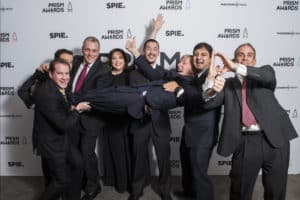
Kevin crowd-surfing his colleagues at the SPIE PRISM awards show
In 2019, the DOF-5 won the LEAP Award, and was named a finalist in the 2019 SPIE PRISM Awards for Optics & Optomechanics. Dover Motion has been very successful with the DOF-5 and it has displaced traditional piezo technology for focusing microscope objectives with very high performance, compact size, and a cost effective price point.

David (Dig)Thomas and Kevin McCarthy presenting the DOF all-in-one board
Given the success of the DOF-5, it was only natural to start pushing the boundaries of the current capabilities of Dover Motion’s traditional travel XY stages. Kevin felt very comfortable that we could put a complete low noise / high performance servo motion controller in the same cross-section as our existing line of MMX stages. Consistent with Kevin’s track record in pushing the boundaries of technology, he decided to set the goals aggressively, targeting the 50 mm stroke MMX stage footprint, which is 110 mm long and only 25 mm tall.
That was going to be difficult, as there are a lot of parts that need to fit into a very small space. The crossed roller guideways, a linear motor with a magnet array and coil, 1.25 or 5nm resolution encoder, limit switches, and all the electronics to support the communications and I/O. Determining how to also put a complete 20 kHz high performance servo drive and control in the same footprint was definitely going to be a challenge!
The Dover Motion team led by David Thomas (aka Dig) rose to the occasion, and under Kevin’s leadership, managed to fit everything into that compact 50 mm travel form factor, which was trademarked as “SmartStage™ XY”, which also includes 100, 150, and 200 mm travel versions. These were and are truly, breakthrough products which eliminate meters of cables and bulky, even rack mount controls.
| wdt_ID | Dover Motion SmartStage XY | Traditional Linear Motor Stage | Traditional Leadscrew Stage | |
|---|---|---|---|---|
| 1 | XY Travel (mm) | 100 x 100 mm | 100 x 100 mm | 100 x 100 mm |
| 2 | Volume Including Controls (cm3) | 1,477 | 2x Larger | 4x Larger |
| 3 | Weight (kg) | 2.2 | 40% Heavier | 30% Heavier |
| 4 | Cable Count (# of cables for XY stack) | 1 | 4 | 4 |
In 2021, the SmartStage™ XY was awarded both the LEAP and IDEA! awards for innovation in motion control. The controller and the stage are incredibly compact, so this is highly differentiated, and patent protected. Kevin is listed as the inventor on both of these patents.
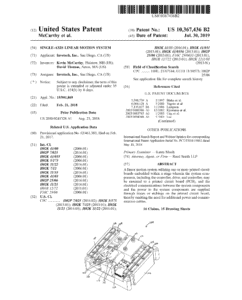
Kevin’s childhood experiences paved the way for his many accomplishments in his professional career. From his early interest in science and physics, an inquisitive kid obsessed with optics, to graduating from MIT and living deliberately on the farm in NH, to all of the accomplishments that followed through his career, 40 years has been quite the journey.
Vince Rolleri stated, “Forty years on, and Kevin has yet to lose a step with respect to his vigor developing novel and unique conceptual approaches to solving complex precision motion challenges.” Kevin’s commitment to constantly pushing the boundaries of technology is to be both admired and celebrated.
We celebrate Kevin’s commitment and the passion he brings to our team and to our customers. Thank you, Kevin, for all of your many incredible contributions over the past 40 years.
